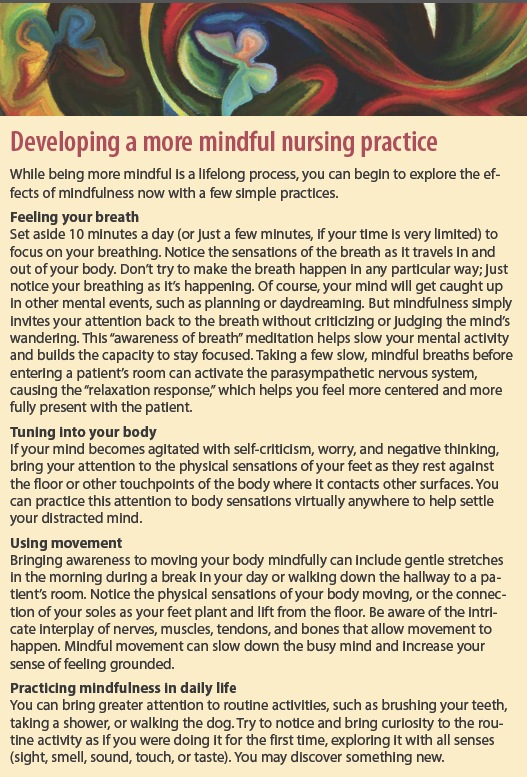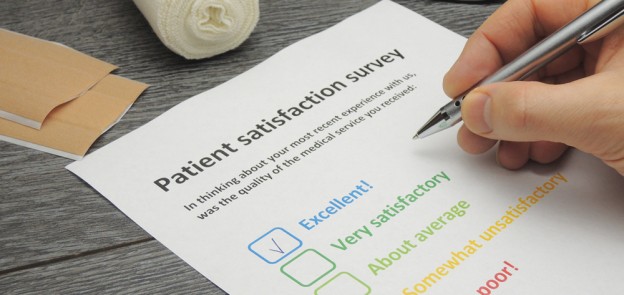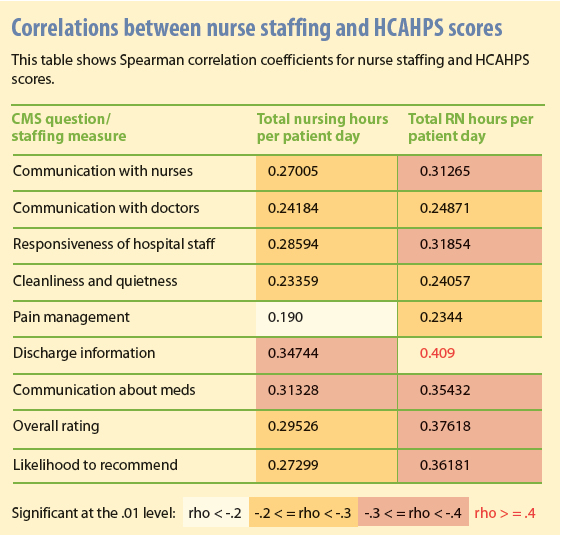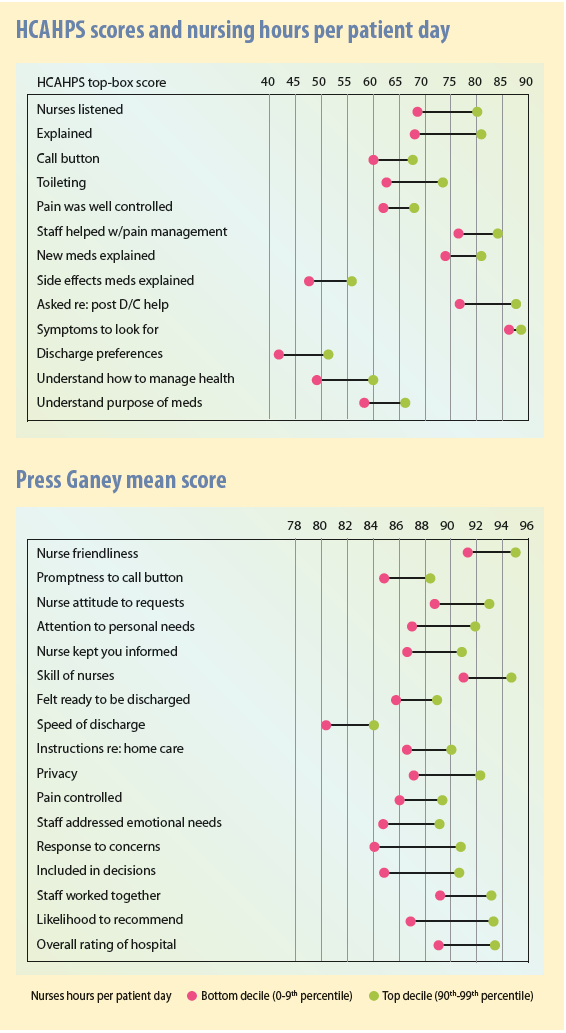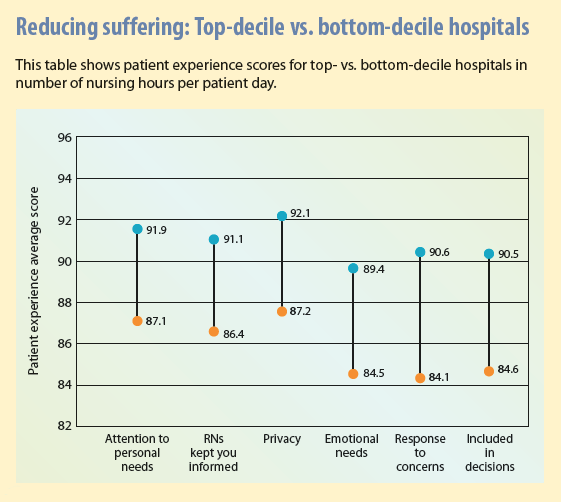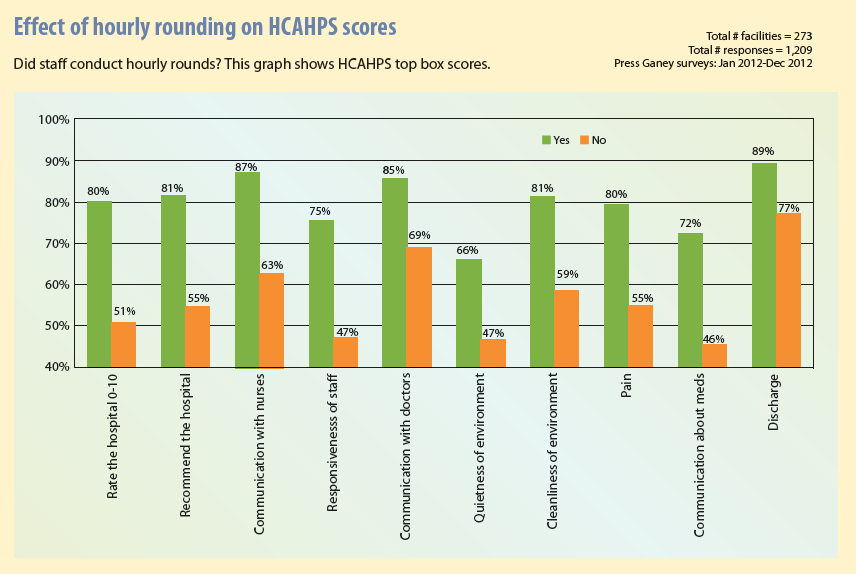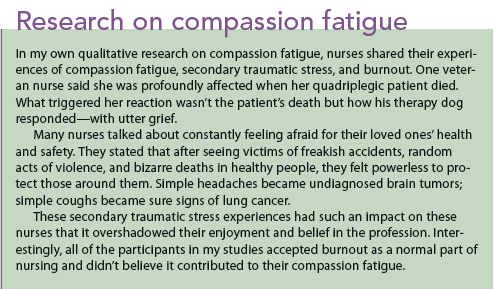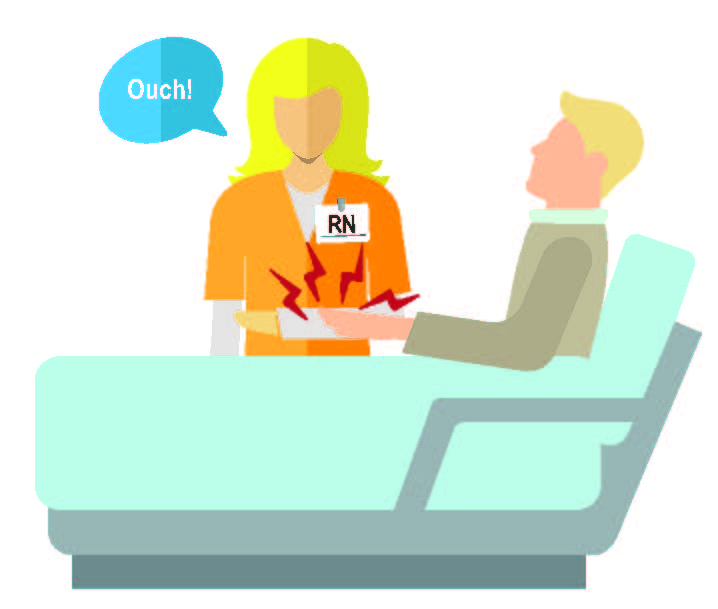In this chapter from A Nurse’s Step-By-Step Guide to Transitioning to the Professional Nurse Role, the authors examine the types of violence nurses face and provide strategies to reduce violent behavior.
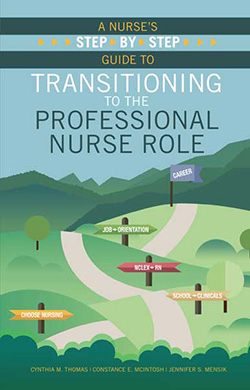 As
you transition to the registered nurse (RN) role or to a new role
within the professional practice, you may encounter some difficult
people who exhibit a variety of violent behaviors. Healthcare is not
immune to violence. As a nurse you are interacting with many people who
are ill, under stress, anxious, under the influence of drugs or alcohol,
living with mental health disorders, or fearful of the future.
Patients, family members, and even your peers may not handle stress well
or may become overwhelmed by the pressures of difficult situations. You
may have already experienced or witnessed violent behaviors from a
patient, family member, or, sadly, another nurse or physician. Our goal
in this chapter is to alert you to the many forms of violence in
healthcare and provide strategies to reduce or defuse the behaviors.
As
you transition to the registered nurse (RN) role or to a new role
within the professional practice, you may encounter some difficult
people who exhibit a variety of violent behaviors. Healthcare is not
immune to violence. As a nurse you are interacting with many people who
are ill, under stress, anxious, under the influence of drugs or alcohol,
living with mental health disorders, or fearful of the future.
Patients, family members, and even your peers may not handle stress well
or may become overwhelmed by the pressures of difficult situations. You
may have already experienced or witnessed violent behaviors from a
patient, family member, or, sadly, another nurse or physician. Our goal
in this chapter is to alert you to the many forms of violence in
healthcare and provide strategies to reduce or defuse the behaviors.
Types of Workplace Violence
Violence
in the workplace is not new, and nursing is not an exception to
violence. In fact, workplace violence occurs in healthcare more often
than it does in any other workplace environment (Howard & Gilboy,
2009). In 2013, Speroni, Fith, Dawson, Dugan, and Atherton found that
76% of nurses reported experiencing a verbal or physical attack (2013).
The United States Bureau of Labor Statistics (2010) reported healthcare
employees were the victims of over 11,370 assaults, a 13% increase since
2009. Violence in the workplace is considered to be acts of physical
and verbal assaults and threats aimed toward a person while that person
is at work (Howard & Gilboy, 2009). There were at least 2,130
assaults occurring in nursing and residential care facilities, and
assaults are most likely a higher number since many assaults are not
reported.
The assaults can inflict physical or emotional harm to employees,
visitors, and patients (McPhaul & Lipscomb, 2008; Papa &
Venella, 2013). Though much of the violence comes from patients,
nurse-to-nurse violence is one of the highest forms, followed by
physician-to-nurse (Thomas, 2010).
Violence comes in many fashions (see Table 8.1), including
threatening behaviors, verbal and written statements, and physical
attacks of biting, hitting, kicking, shoving, throwing things, and
pushing people (Sullivan, 2013). More violent behaviors might include
the use of guns or knives, rape, sexual harassment, or murder (Sullivan,
2013).
There are many names for violence in the workplace, such as lateral violence, horizontal violence, and bullying
(Thomas, 2010). Many states are taking a more proactive approach to
stopping violence in healthcare facilities by making it a felony to
assault or commit battery against emergency department nurses (Trotto,
2014). There is a drive to have Congress pass legislation for increased
preparation for, recognition of, and de-escalating of violent behaviors
in healthcare organizations (Trotto, 2014).
Table 8.1 Common Types of Workplace Violence
|
|---|
Nurse-to-Nurse
|
Physician-to-Nurse
|
Patient-to-Nurse
|
Yelling in the nursing station, hallway, or patient room
|
Throwing things at a person or in a room
|
Kick, a physical act
|
Not acknowledging a request by simply avoiding or walking
away from the person
|
Making derogatory remarks toward a
person or to others
|
Hit, a physical act
|
Sighing, a covert action (not openly displaying behavior)
|
Making sexual
comments to a person
or to others
|
Biting, a physical act
|
Eye rolling, a covert action (not openly displaying behavior)
|
Yelling directly or indirectly to the person
|
Throwing things, a physical act
|
Gossiping about the person to others
|
Hanging up on a phone call
|
Threatening a person directly or indirectly
|
Making rude comments to a person or to others
|
Making demeaning remarks directly or indirectly to the person
|
Using guns, knives, or other weapons directly or indirectly on the person
|
Threatening someone
|
Making a person the brunt of jokes directly or indirectly
|
Calling the person names or referring negatively to gender, sexual orientation, or ethicality
|
Excluding someone
from the team
|
Making threatening comments directly to the person
|
|
What Causes Violence?
The
nurse’s job can at times be stressful. Nurses often work 12-hour shifts
in difficult situations. They are working with a variety of people with
different personalities and coping mechanisms, and often people have
unrealistic expectations of nurses and other healthcare providers. When
people are sick, they frequently behave differently. Patients and family
members may exhibit a fear of the unknown and lash out in frustration.
Gates, Gillespie, and Succop (2011) believe that working in
healthcare increases the risks for violent behaviors, much of it being
created by stress. In addition, emergency departments are prone to
violent behaviors by nature of psychiatric and confused patients,
alcohol and drug abusers, and violent patients such as murderers and
gang members (Gates et al., 2011; Wood & Brott, 2013). Psychiatric
departments and hospitals, emergency departments, geriatric facilities
such as Alzheimer’s facilities, and overcrowded waiting rooms are
potential areas for increased violent events (Nachreiner et al., 2007).
Additionally, nurses who work alone or with limited staff, who work in
areas with longer waiting times, and who spend time in less secure
spaces like parking lots and dimly lit areas are at increased risk of
violent behaviors (Glacki-Smith et al., 2010; Sullivan, 2013).
Reducing the Risk of Being a Victim of Violence
No
one should be subjected to violent behaviors regardless of the
magnitude of the behavior. The workplace should be a safe environment
that is free from intimidation and fear. Nurses should not hesitate to
ask questions and seek help when needed.
Realistically,
policies are effective only if the people working within the
organization are willing to enforce them. Be willing to report someone
who is bullying or displaying violent behaviors toward you.
The Joint Commission mandated that all healthcare organizations
have a zero-tolerance policy and procedure in place to address and
eliminate violence from the work environment (The Joint Commission,
2012). You can review this policy at http://www.jcrinc.com/assets/1/7/ECNews-Jan- 2012.pdf. Knowing your organization’s policies and procedures on violence is vital and helps to protect you as a potential victim.
Nurses must know the warning signs of an impending violent event
and be able to either defuse it or get help. Consider these great tips
to recognize violent warning signs when someone:
- Stands close or moves aggressively toward you
- Yells or escalates his or her voice when you attempt to talk to the person
- Elevates his or her arms in a fighting or striking position
- Stares blankly or appears disconnected
- Clenches or hits his or her fists
- Possesses or brandishes a weapon of any type: pen, knife, gun, heavy object, or even a patient chart
- Makes angry comments such as “I’m going to kill you” or “I’m going
to knock your brains out” or “I’ll be waiting for you in the parking
lot”
- Attempts to prevent you from leaving or moving out of the way by standing in front of you or barring the door or exit
- Bars you from retreating to a safe place (Sullivan, 2013; Wood & Brott, 2013)
Following are the steps you can take in these situations to protect yourself and others:
- Do not approach or try to take a weapon from a person.
- Do not turn your back on the person, but slowly walk backward, keeping your vision on the person at all times.
- Call Security or 911, or call out for help or for someone else to call 911 or Security.
- Remain calm and avoid threatening a violent person, slow your breathing, and change the subject, if necessary.
- Protect other patients, close other patient room doors, lock unit or office doors, and direct people away from the area.
- Do not allow the violent person to be close to the door if in a room; remain by the door so that you can exit quickly if needed.
- Move to a safe area. (Sullivan, 2013; Wood & Brott, 2013)
Report abusers immediately, using the appropriate steps in your organization.
The Not-So-Obvious Workplace Violence
The
sad fact is that violence is a negative part of healthcare, and nurses
must learn how to recognize and protect themselves from falling victim
to such behaviors. Most nurses have been subjected to some form of
violence during their careers (Speroni et al., 2013; Thomas, 2010).
Maybe you have also, but brushed it off as just part of the job. The
incident may be as simple as another nurse rolling her eyes when asked a
question or reach the level of bearing witness to a physician throwing a
chart or personally experiencing sexual harassment.
New nurses are especially vulnerable to violence but may not
recognize it as such (Thomas, 2010). Some not-so-obvious violent
behaviors are someone giving the silent treatment, sighing, walking away
when approached, refusing to help when asked, giving angry looks, and
excluding others. Consider the following examples of not-so-obvious
bullying incidents.
The Eye Roll
What it is:
You may recall as a child rolling your eyes whenever your parents told
you to do something you didn’t want to do. It was a subtle covert action
that indicated your displeasure with something.
Example: Mary, a new nurse, asks Bill, an
experienced nurse, for help to program an IV infusion machine. Bill
rolls his eyes so that other nurses can see his objection to the request
and pretends that he does not hear Mary.
Ways to deal with it: Mary should
confront Bill about the incident. Mary is confronting Bill’s behavior,
not Bill personally. Mary might say something like this: “I know I ask
for help often, but I am still learning. You are the best nurse to help
me because you are so good with problems like troubleshooting the IV
machines.” This statement lets Bill know that Mary values his help and
expertise and potentially defuses a violent behavior.
Ignoring
What it is: Ignoring happens when you make a request or ask a question to another person who does not acknowledge you or the request.
Example: Rose, an LPN, was floated to the
4South medical unit today. She has never worked on this unit and is
unsure of the routines. Rose asks Connie, one of the regular unit
nurses, when vital signs are generally taken. Connie responds by simply
ignoring Rose. In fact, Connie gets up and walks out of the nursing
station without addressing Rose’s question.
Ways to deal with it: One way to deal
with ignoring situations is to confront the person about the behavior.
You might say something like this: “I have never worked on this unit,
and I am willing to do whatever work I am qualified to do, but I need
some initial direction about the unit routine. Would you be willing to
answer some of my questions?”
The Angry Doctor/Teammate
What it is:
Dr. Jackson is well known for his difficult behaviors, and in fact,
many nurses simply accept his behaviors and pass along this advice:
“Well, that’s just how he is, and you will get used to him.”
Example: Sally, an RN, is assisting Dr.
Jackson with a bedside lumbar puncture procedure. Dr. Jackson asks for a
medication that is not normally given during the procedure and is not
among the medications in the room. Sally informs him that she will have
to leave the room or call another nurse to obtain the medication, which
will delay the procedure. Dr. Jackson lashes out at Sally, yelling and
cursing that she should have been more prepared and he will report her
to the nurse manager.
Ways to deal with it: Sally should not
accept the abusive behavior that Dr. Jackson is displaying. An
appropriate response would be for Sally to calmly state, “Dr. Jackson, I
will not accept being cursed at or yelled at by you. If I had been
notified prior to the procedure that you might want that particular
medication, I would have ensured it was present. If I step out of the
room to obtain the medication, it might present a safety issue for the
patient; therefore, I will call another nurse to obtain the medication
as soon as possible.”
Excluded from the TeamWhat it is: Being
excluded from the team is another form of violence. It implies that you
are not worthy, that you are not part of us, that we don’t care about
you. Being excluded may result in a hostile work environment.
Example: Cheryll was a new registered
nurse working the night shift on a busy medical surgical unit. The more
experienced nurses had all been working together on the unit for at
least 6 years and were friends outside the organization as well. Cheryll
had never felt part of the team, because the nurses tended to exclude
her from conversations or not invite her to social events outside of
work.
Ways to deal with it: The unit was
particularly busy one night with several new admissions from the
emergency department. Cheryll had completed only two admission
assessments on her own and was concerned about her ability to complete
the admission assessment on a patient with multiple acute health issues
and family members with lots of questions. She decided to seek help from
Beth, one of the more experienced nurses, who was sitting at the
nursing station.
When Cheryll asked Beth for help completing the admission
assessment, Beth pretended she did not hear Cheryll and walked out of
the nursing station. Frustrated, Cheryll decided to find Beth and ask
her again for help. As she approached a patient room, Cheryll overheard
Beth talking about her to another nurse on the unit. “She is so stupid.
What did they teach this girl in nursing school, anyway? She can’t do
anything for herself. I wish they would have never hired her. She
doesn’t fit in.”
Subsequently, Cheryll went back to her patient room and completed
the admission assessment on her own. The next evening when she reported
to work, the nurse manager asked to meet with her. Cheryll was given a
written warning, composed by Beth, for making an error of omission for a
routine medication the patient had been taking before the hospital
stay. Cheryll was so upset that she resigned her position to evaluate
whether she should remain a nurse.
Being excluded from the team can be very difficult. Exclusion is
also a form of violence because it sets the person apart and sends the
message “You are not one of us.” Cheryll should have confronted the
nurse’s actions and explained that she is new to nursing and to the unit
and needs help from experienced nurses. If Cheryll believes the nurse’s
actions are creating a hostile work environment, she would need to make
a formal complaint to the nurse manager. Though it is not required that
a nurse is included in personal activities outside of the work
environment and it is not necessary that everyone likes everyone else,
nurses must be respectful to each other and work as a team or a cohesive
group to maintain a safe, quality work environment.
Workplace Injuries
Many
injuries are the result of workplace violence and need to be addressed
to bring awareness and to support education and prevention programs.
Other situations happen in healthcare organizations resulting in
workplace injuries that may have been prevented. Nevertheless, nurses
must be aware of potential risk factors in healthcare organizations to
minimize their risk of injury.
Knowing how to avoid injuries and employ proper safety techniques
for yourself and your patients is vital. Not surprisingly, injuries such
as in the back and neck occur most often in healthcare environments and
are estimated to cost more than $7 billion every year (Nordqvist,
2013). The American Nurses Association (ANA) statement makes it clear
that back, neck, and shoulder injuries are preventable with the proper
education and equipment (Nordqvist, 2013).
Many types of injuries can happen in healthcare organizations. The
Centers for Disease Control and Prevention (CDC) reported that
healthcare workplace injuries included needle sticks, latex allergies,
back and neck injuries, violence, stress, exposure to chemicals,
disease, and illnesses such as blood- borne pathogens (2014a). Nonfatal
injuries in healthcare rank among the highest of any industry (CDC,
2014a).
The law mandates, though it may be difficult, that employers provide a
safe environment for workers. The nature of healthcare predisposes
nurses to viruses, bacteria, and a large number of illnesses. Exposure
to needle stick injuries places nurses at risk for the hepatitis B and C
viruses as well as for human immunodeficiency virus (HIV) (CDC, 2014b).
We tend to think of sharps primarily as needles, yet nurses work in
a variety of places and are exposed to a multitude of sharp items.
Among the more common are scalpels, lancets, razor blades, scissors,
wire, retractors, clamps, pins, staples, cutters, and glass (Canadian
Centre for Occupational Health and Safety [CCOHS], 2014). Some diseases
contracted through sharps injuries are brucellosis, diphtheria,
cutaneous gonorrhea, herpes, malaria, staphylococcus, syphilis,
toxoplasmosis, and tuberculosis (CCOHS, 2014).
Unfortunately, sharps are often easily accessible to someone intent
on harming another person. It would not be particularly difficult to
pull used syringes from a needle box hanging on a wall, use the foam
antiseptic spray to temporarily blind someone, or grab some lancets to
stab another person. Heavy or falling equipment, burns, and inhalants
can also injure nurses. Therefore, nurses must be diligent in
maintaining safety awareness for not only their patients but also
themselves.
Musculosketal injuries are among the most frequent physical
injuries and are attributed to moving patients from the bed to the chair
or stretcher, repositioning, and attempting to prevent a patient from
falling (Stokowski, 2014). Additionally, repeated tasks that require
bending, pushing, and pulling may also be problematic (Stokowski, 2014).
The impact of
the injury may not be fully realized until much later, as it is the
cumulative effect that is most troubling to the nurse.
If you have experienced a musculosketal injury, be sure to complete
and submit the organization’s incident report. You should also be seen
by a physician or another care provider for a physical assessment to
determine the extent of the injury.
To prevent further injury, follow the organization’s policies and
procedures for proper lifting, transferring, and moving patients. If the
organization provides lift equipment, you need to use it. If you do
not, get additional help when moving patients or doing any type of heavy
lifting. If you have been placed on lifting restrictions, follow them
for the stated length of time. Review and implement proper body
mechanics for lifting.
Nurses may also be accidentally shocked by equipment and emergency
resuscitation paddles, and there is the potential to be burned by using
cauterization machines. Cleaning solutions and disinfectants may cause
inhalation problems and exacerbate allergies.
Many nurses work in radiation therapy and therefore are at risk for
radiation exposure and burns. Because radiation is invisible and
odorless, there is no way to be sure of exposure. At the minimum, nurses
may experience nausea, vomiting, erythema, dermatitis, and diarrhea;
however, long-term exposure may cause cancer, sterilization, bone marrow
suppression, congenital defects, and death (Stokowski, 2014).
Nurses working with lasers are potentially at risk for thermal
injury to the skin and eyes (Stokowski, 2014). Surgical nurses are in
danger of inhalation problems from toxic gases and blood-borne pathogens
(Pierce, Lacey, Lippert, & Franke, 2011).
You must use caution when handling urine, stool, blood, and emesis
by wearing gloves and a face shield when necessary. The Occupational
Safety and Health Administration (OSHA) has developed the simplified
document Hazard Communication Standard, providing a more common
and understandable approach to categorizing chemicals and communicating
hazard information. The updated document is the Employee Right to Understand, at https://www.osha.gov/dsg/hazcom/ghd053107.html (Stokowski,
2014). Though Stokowski points out that proper education is paramount,
avoiding the chemicals when possible is preferred (2014).
Protecting Yourself
No one will protect you like you will. Be in control of your
personal well-being. Know the policies on workplace violence where you
work, and know how to prevent it from happening or how to report violent
behaviors from others. Ensure that you are aware of the organization’s
policies and procedures for workplace safety. Know where to locate the
information and what to do if you find faulty equipment or if you or a
coworker is injured. Follow all isolation procedures and other safety
precautions established in your organization. Be aware of your
surroundings and of the people who are present when you are working.
Most importantly, know how to protect yourself from developing a
workplace injury or from being a victim of violence.
The following list gives you some ways to protect yourself:
- Wear protective gear when appropriate, such as a mask, an eye shield, gloves, shoe covers, and gown.
- Do not recap needles.
- Use needleless devices when appropriate.
- Dispose of used needles immediately into sharps containers.
- If you are moving across the room to dispose of a used syringe, hold
the syringe upright in front of you to avoid sticking yourself or
others.
- Engage in safety continuing education programs.
- Use adequate lighting.
- Check instrument trays for sharp spots before picking up.
- Avoid chemical exposure, wear proper protective clothing when necessary, and avoid exposure when possible.
- Minimize radiation exposure by wearing protective clothing and avoiding radiation when possible.
- Properly dispose of contaminated material.
- Complete and submit an incident report if you sustain an injury, and seek a medical assessment to substantiate the injury.
- Stop workplace violence, know your organization’s policies, refrain
from violent behavior, confront situations whenever possible, and report
people who exhibit violent behaviors.
Healthcare organizations are complex, and many people come and go
every day. Nurses are caring for patients with a variety of emotional,
psychosocial, and physical illnesses. Family members may be stressed and
may lack coping skills to deal with complex and emotional decisions.
Violence in healthcare organizations is among the highest in all
working environments, and it impacts the safety of not only nurses but
also other providers of care and our patients. Violence may come in many
forms, from the not-so-obvious eye rolling and sighing to more violent
behaviors such as gunshots, stabbings, and physical assaults that may
result in physical and emotional injury and even death.
In addition, nurses are working with lots of different equipment,
some of it heavy, bulky, and unstable and often in confined spaces.
Nurses are also exposed to many different hazards such as inhalants,
topical chemicals, blood-borne pathogens, diseases, high-voltage
electrical equipment, and instruments that may result in puncture wounds
or skin lacerations. Nurses should be aware of the many potential
hazards in the workplace and opportunities for people to commit violent
behaviors and then learn how to protect themselves from violence and
injury.
Chapter Checkup
Key points from this chapter include:
- As a nurse, you will face violence, in both obvious and non-obvious ways.
- Recognize the many types of violent behaviors.
- Reduce the possibility that you become a victim of violence.
- Avoid workplace injuries.
- Protect yourself from an injury.
- Know what to do if you sustain an injury. RNL
Cynthia M. Thomas, EdD, MS, RNc, is an associate professor at Ball State University School of Nursing. Constance E. McIntosh, EdD, MBA, RN, is an assistant professor at Ball State University School of Nursing. Jennifer S. Mensik,
PhD, MBA, RN, NEA-BC, FAAN, is executive director of On Nursing
Excellence and the Institute for Staffing Excellence and Innovation.
Information on purchasing A Nurse’s Step-By-Step Guide to Transitioning to the Professional Nurse Role.
Gates, D. M., Gillespie, G. L., & Succop, P. (2011). Violence against nurses and its impact on stress and productivity. Nursing Economics, 29(2), 59–66.
Glacki-Smith, J., Juarez, A. M., Boyett, L., Homeyer, C., Robinson,
L., & Maclean, S. (2010). Violence against nurses working in U.S.
emergency departments. Journal of Nursing Administration, 39(7–8), 340–349.
Howard, P. K., & Gilboy, N. (2009). Workplace violence. Advanced Emergency Nursing Journal, 31(2), 94–100.
Nachreiner, N. M., Hansen, H. E., Okano, A., Gerberich, S. G.,
Ryan, A. D., McGovern, P. M., … Watt, G. D. (2007). Difference in
work-related violence by nurse license type. Journal of Professional Nursing, 23(5), 290–300.
Papa, A., & Venella, J. (2013). Workplace violence in healthcare: Strategies for advocacy. The Online Journal of Issues in Nursing, 18(1). doi: 10.3912/OJIN.Vol18NO01Man05
Pierce, J. S., Lacey, S. E., Lippert, J. F., & Franke, J. E.
(2011). Laser-generated air contaminants from medial laser applications:
A state of the science review of exposure characterization, health
effects, and control. Journal of Occupational Environment Hygiene, 8, 447–466.
Speroni, K. G., Fitch, T., Dawson, E., Dugan, L., & Atherton,
M. (2013). Incidence and cost of nurse workplace violence perpetrated by
hospital patients or visitors. Journal of Emergency Nursing, 40(3), 218–228. doi: http://dx.doi.org/10.1016/j.jen.2013.05.014
Sullivan, E. J. (2013). Effective leadership and management in nursing (8th ed.). Upper Saddle River, NJ: Pearson.
Thomas, C. M. (2010). Teaching nursing students and newly
registered nurses strategies to deal with violent behaviors in the
professional practice environment. The Journal of Continuing Education in Nursing, 41(7), 299–310.
